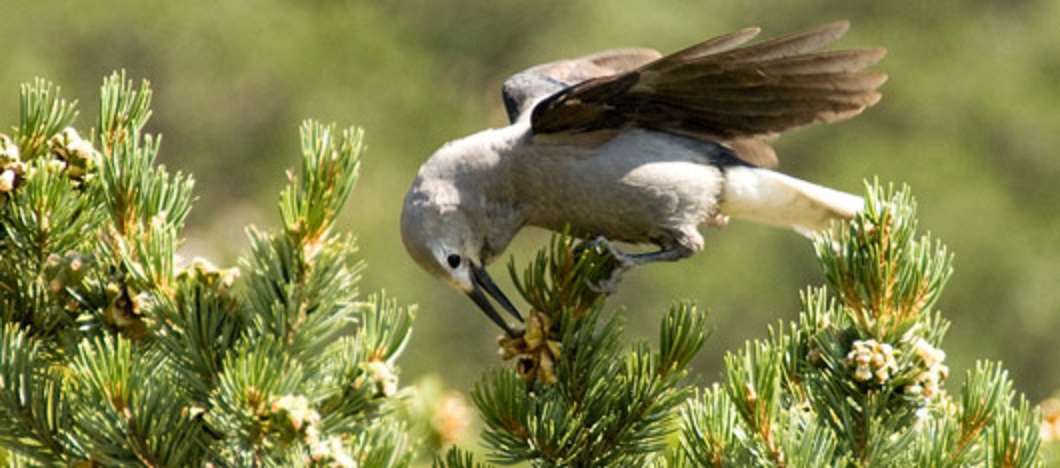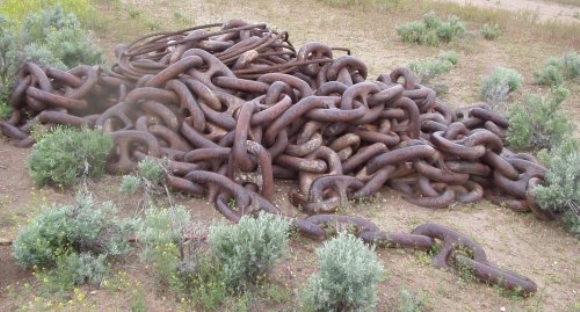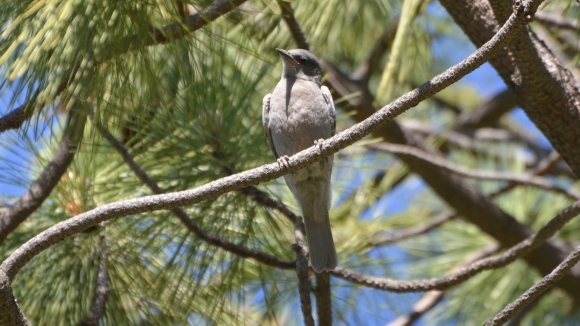by Will Falk / Deep Green Resistance
A windmill blade knocks the head off a Cooper’s hawk interrupting the late afternoon peace in Spring Valley, just outside Ely, Nevada.
The blade tosses the hawk’s body onto yellow gravel the power company spread, over living soil, in circles around their windmills.
The ever-present Great Basin breeze, who usually whispers with a soothing tone through pinyon needles, juniper branches, and sage tops, becomes angry. Grazing cows pause their chewing and look up to consider the scene.
Heads of cheat grass poke through the gravel, only to droop with sorrow for the splayed feathers and twisted wings at their feet. Taller than cheat grass and crowding around the gravel’s edge, crested wheatgrass shakes and shutters with horror in the wind.
The collision’s suddenness and the sickening sound of the blade striking the hawk’s small skull breaks my awareness open with a pop. I seep across the valley floor. I mingle with the wounds on the land and recognize pain in places I previously overlooked. The windmills, the invasive plants, the cows, and the empty scars on the foothills marking pinyon-juniper clearcuts are all evidence of violence.
The gravel at my feet is the remains of stones and boulders that were exploded and crushed, loaded into trucks, and transported to Spring Valley as part of Pattern Energy’s Spring Valley Wind Farm project. Windmill construction means so much involves land clearances, building maintenance roads, and operation of fossil-fuel intensive heavy machinery.
Before the gravel was dumped and the construction project started, the ground I stand on was covered in a complex mosaic of lichens, mosses, microfungi, green algae, and cyanobacteria that biologists call a “biological soil crust.”
Across the Great Basin, biological soil crusts are integral to protecting soil surfaces from erosion. They are also vulnerable to disturbance by construction projects like the one that brought the windmills here. The lichen components of these disturbed crusts can take 245 years to recover. Far worse, soil losses due to erosion following mechanical disturbances can take 5,000 to 10,000 years to naturally reform in arid regions.
The windmills that tower above me fill the air with a buzzing, mechanical sound. Built only four miles from a colony of millions of Mexican free-tailed bats at the Rose Guano Cave, the windmills killed 533 bats in 2013, triple the amount allowed by federal regulations. The majority of these bats are killed by barotrauma. Rapid or excessive air pressure change, produced by windmills, causes internal hemorrhaging. In less abstract language, the bats’ lungs explode.
Both cheatgrass and crested wheatgrass are invasive species. Global shipping routes, which have long been tools of colonialism, brought cheatgrass to North America through contaminated grain seed, straw packing material, and soil used as ballast in ships. Cheatgrass outcompetes native grasses for water and nutrients. It drops seeds in early summer before native grasses and then drys out to become highly flammable.
When wildfires rip through areas cheatgrass has invaded, native grasses are destroyed without seeding. In the fall, after native grasses have burned, cheatgrass seeds germinate and cheatgrass dominance expands. This dominance has been disastrous for the Great Basin. Fire return intervals have gone from between 60-110 years in sagebrush-dominated systems to less than 5 years under cheatgrass dominance.
While cheatgrass was imported by accident, crested wheatgrass was imported from Asia in 1898. By the 1890s, Great Basin rangelands were depleted of water, soil, and economically useful vegetation. Ranchers needed cheap feed for their livestock and crested wheatgrass provided it. It outcompetes native grasses, grows in tight bunches that choke out other species, quickly forms a monoculture, and reduces the variety of plant and wildlife species in places it takes hold. Worst of all, crested wheatgrass supports a destructive ranching industry that should have collapsed decades ago.
Ranching is one of the most ecologically destructive activities in the Great Basin. Livestock grazing depletes water supplies, causes soil erosion, and eliminates the countless trillions of small plants forming the base of the complex food web supporting all life in the region. Ranchers have nearly killed off all the top carnivores on western rangelands and jealously guard their animals against the re-introduction of “unacceptable species” like grizzly bears and wolves.
Ranchers, always searching for new rangeland, encourage government agencies like the Bureau of Land Management (BLM) and the US Forest Service (USFS) to clear-cut forests and remove sagebrush to encourage the growth of graze for their livestock. In the hills north of the wind farm, pinyon pines and junipers lie in mangled piles where they were “chained.”
Chaining is the preferred method for destroying forests here. To chain a forest is to stretch a US Navy battleship anchor chain between two crawler tractors which are then driven parallel to each other while ripping up every living thing in their path.
Nevada Highway 893 runs to my left along the west side of the valley. If I followed the road north a few miles, I would run into one of the Southern Nevada Water Authority’s (SNWA) test wells. SNWA installed these wells in the preparation of its Clark, Lincoln, and White Pine Counties Groundwater Development Project that would drain Spring Valley of water and, then, transport the water by pipeline to support Las Vegas’ growing population.
Fortunately, the project has been successfully stalled in court by determined grassroots activists. But, if SNWA eventually prevails, Spring Valley will quickly dry up and little life, endemic or invasive, will survive here.
***
The reminders of violence I encounter in Spring Valley reflect global problems. Windmills are a symptom of the dominant culture’s addiction to energy. The roads here will carry you to highways, highways to interstates, and interstates to airports.
There is virtually nowhere left on Earth that is inaccessible to humans with the privilege, power, and desire to go wherever they will. To gain this accessibility, these humans are so thoroughly poisoning the atmosphere with greenhouse gas emissions global temperatures are rising.
Invasive species – cows, cheat grass, crested wheatgrass, European settlers – are colonizers. They each colonize in their own way. The cows replace elk, pronghorn, wolves, and bears. The grasses eliminate natives by hoarding nutrients and water. They reproduce unsustainably and establish monocultures. When that doesn’t work, they burn the natives out. And, the settlers do the same.
The violence of civilized life becomes too obvious to ignore and the land’s pain threatens to overwhelm me. Despair accompanies these moments. When all I see is violence, it is easy to conclude that violence is all there is, all there ever was, and all there ever will be. Claims I’ve heard repeated countless times echo through my mind.
Humans are selfish. This is just what we do. We will kill ourselves, but the planet will recover…eventually. Humans have been butchering each other for centuries and we’ll butcher each other for centuries more if we don’t destroy the world first.
I stand paralyzed under a windmill, with a decapitated hawk at my feet, struggling through my thoughts for who knows how long, when the blue feathers of a pinyon jay catch my eye. At first, it’s the simple beauty of her color that attracts my attention. But, it’s the strangeness of the phenomenon that keeps my attention.
Rows of windmills form the wind farm. I stand under the northernmost row and about one hundred yards separate the rows. The jay lands on a barbed wire fence post about halfway between the row I’m standing under and the first row south of me. Her presence is strange for two reasons. First, pinyon jays prefer to live in pinyon-juniper forests and there are no trees for a mile in either direction. Second, pinyon jays are very intelligent, and she must have known that to brave the circling windmill blades is to brave the same death the Cooper’s hawk just experienced or the barotrauma so many bats experience.
The despair I felt a few moments ago is fading. As I approach the jay I see her picking through a pinyon pine cone. She picks deftly at it before she pulls a pine nut from the brown folds of the cone. It’s not until she lifts her head, with the pine nut in her beak, that I understand.
She flew down from the forests, through dangerous windmill blades, to show me a pine nut.
***
Pine nuts represent the friendship humans and pinyon-juniper forests have shared for thousands of years. Pinyon charcoal and seed coats have been found in the 6,000-year-old Gatecliff Shelter in central Nevada. Pinyon seed coats have been found with 3,000-year-old artifacts in Hogup Cave in northwestern Utah. Many of the Fremont culture’s ruins (circa 1000 AD) in eastern Utah also show pinyon use.
Pine nuts are symbols of true sustainability. I’ve heard many traditional, indigenous people explain that sustainability requires making decisions with the succeeding seven generations in mind. When the health of the seventh future generation guides your relationship with the land, overpopulation, drawdown, pollution, and most forms of extraction become unthinkable. European settlers arrived to find indigenous peoples in the Great Basin, like so many indigenous peoples around the world, living in cultures that existed for centuries in balance with the land.
And, the pine nut made these cultures possible.
The Washoe, Paiute, and Shoshone all developed cultures centered on pine nuts. Pinyon pine expert, Ronald Lanner notes, “Just as life on the plains was fitted to the habits of the buffalo, life in the Great Basin was fitted to the homely, thin-shelled nut of the singleleaf pinyon.” Pinyons give their nuts freely and harvesting them involves no damage to the trees. In fact, pine nuts are seeds. Animals who collect and gather the seeds – like pinyon jays, rats, mice, and humans – help the trees reproduce.
It’s a beautiful relationship: pinyon pines offer animals food, and animals offer pinyon pines regeneration. At a time when the survival of life on Earth depends upon humans embracing their role as animals, the relationship the Washoe, Paiute, and Shoshone built with pinyon pines serves as a model for the world.
Relying on the research of American Museum of Natural History archaeologist David Hurst Thomas, Lanner describes the central role the annual pinyon festival played in Western Shoshone life. He writes, “…when pinyon harvest time arrived, Shoshone bands would come together at a prearranged site. There they would harvest nuts, conduct communal rabbit drives, and hold an annual festival. The pinyon festival was the social highlight of the year and was often attended by several hundred people. At night…there was dancing…There was gambling among men and courting among the young. Marriages were arranged and sexual liaisons conducted.”
Pine nut crops, like all natural processes, are subject to variation. There are good yields and bad yields. Human cultures dependent on the land are constantly confronted with a choice. Either humans can tighten their belts and reduce their populations voluntarily. Or, they can exploit the land, stealing resources from the future to meet the needs of the present.
Lanner describes how Western Shoshone sustainability was maintained, “…the pinyon festival was used as an opportunity for regulating the future size and distribution of Shoshone populations. If at the festival the intelligence from all areas foretold a failure of next year’s crop, then measures could be taken to avoid mass starvation…Births could be limited by sexual abstinence or abortion. One or more twins could be killed at birth, as could illegitimate children…The sick and the old could be abandoned. A widow might be killed and buried beside her husband.”
Some of these measures may seem harsh to us today. But, when we consider the violence necessary to sustain today’s civilized, human populations, we will realize that some of these difficult decisions are what true sustainability looks like. Killing a twin or abandoning the sick is small violence compared to the mass violence of deforestation, anthropogenic desertification, and climate change.
***
The pinyon jay in Spring Valley shows me both a pine nut and the history of human sustainability. Even though Spring Valley, with the rest of the world, currently reflects too much human violence, the vast majority of human history reflects true sustainability. Modern humans have existed for 200,000 years. For the vast majority of that time, most of us lived in cultures similar to the Western Shoshone. We must not forget where we come from.
Meanwhile, ecological collapse intensifies. Violence against the natural world is so pervasive it must be considered a war. Perceiving this war hurts. The pain offers us two choices: endurance or cure. Either the pain is inevitable, an unavoidable fact of life that must be endured. Or, the cause of the pain can be treated and healed.
The pervasiveness of violence tempts us to conclude that it is inevitable. When everywhere we look, we are met with human destruction, it is easy to believe that humans are inherently destructive. This is one reason why the dominant culture destroys the natural world so zealously. If violence is inevitable, there is no reason to stop it.
This is also why the dominant culture works to destroy those non-humans we’ve formed ancient friendships with. If the dominant culture eradicates bison, it destroys our memory of how to live sustainably on the Great Plains. If the dominant culture eradicates salmon, it destroys our memory of how to live sustainably in the Pacific Northwest. If the dominant culture eradicates pinyon-juniper forests, it destroys our memory of how to live sustainably in the Great Basin.
There is a war being waged on the natural world and wars are fought with weapons. The pinyon jay brings me a weapon against the despair I feel recognizing pervasive violence in Spring Valley. She shows me that the violence is not inevitable. She shows me the path to true sustainability, and in doing so, shows me the path to peace.
To learn more about the effort to protect pinyon-juniper forests, go to Pinyon Juniper Alliance. You can contact the Alliance here.
To repost this or other DGR original writings, please contact newsservice@deepgreenresistance.org



